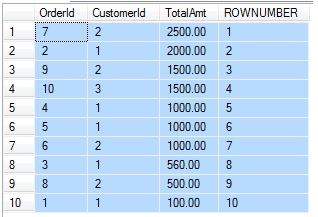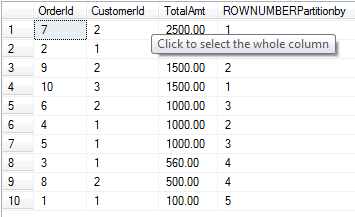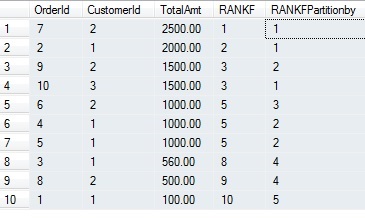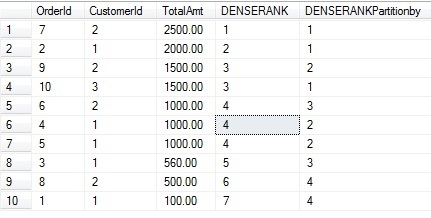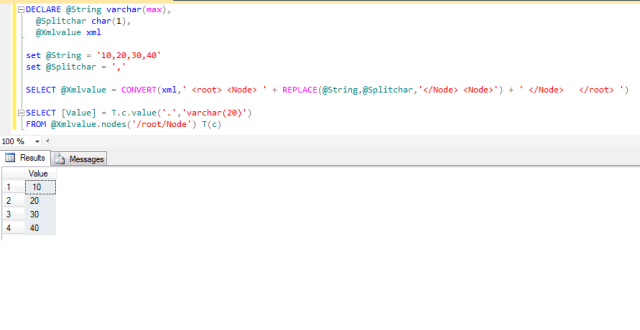Today, We will see example of different ranking functions supported in Sqlserver.
Use below script to create table.
CREATE TABLE dbo.CustomerData
(OrderId INT IDENTITY(1,1) NOT NULL,CustomerId INT,TotalAmt decimal (10,2))
Populate data in table.
INSERT dbo.CustomerData (CustomerId, TotalAmt)
SELECT 1, 100
UNION ALL
SELECT 1, 2000
UNION ALL
SELECT 1, 560
UNION ALL
SELECT 1, 1000
UNION ALL
SELECT 1, 1000
UNION ALL
SELECT 2, 1000
UNION ALL
SELECT 2, 2500
UNION ALL
SELECT 2, 500
UNION ALL
SELECT 2, 1500
UNION ALL
SELECT 3, 1500
Below are list of Ranking function.
1. ROW_NUMBER – It will generate Row Number base on order by and partition by provided in over clause.
SELECT *,ROW_NUMBER() OVER (ORDER BY TotalAmt DESC) AS ROWNUMBER
FROM dbo.CustomerData
ORDER BY TotalAmt DESC
SELECT *,ROW_NUMBER() OVER (PARTITION BY CustomerId ORDER BY TotalAmt DESC) AS ROWNUMBERPartitionby
FROM dbo.CustomerData
ORDER BY TotalAmt DESC
2. RANK – It will Generate rank base on order by and partition by provided in over clause.
Partition by – What ever column written in partition by SQL will logically create partition on that and after on that partition Rank function will apply. Rank will give same rank if value is same for column provided in over clause in order by.
SELECT *,RANK() OVER (ORDER BY TotalAmt DESC) AS RANKF,
RANK() OVER (PARTITION BY CustomerId ORDER BY TotalAmt DESC) AS RANKFPartitionby
FROM dbo.CustomerData
ORDER BY TotalAmt DESC
3. DENSE_RANK – It will Generate rank base on order by and partition by provided in over clause.
Partition by – What ever column written in partition by SQL will logically create partition on that and after on that partition DENSE_Rank function will apply. DENSE_Rank will give same rank if value is same for column provided in over clause in order by, and next number in sequence will generate base on last number use in sequence, you can see in below example.
SELECT *,DENSE_RANK() OVER (ORDER BY TotalAmt DESC) AS DENSERANK,
DENSE_RANK() OVER (PARTITION BY CustomerId ORDER BY TotalAmt DESC) AS DENSERANKPartitionby
FROM dbo.CustomerData
ORDER BY TotalAmt DESC
Below is query by which you compare all the ranking function.
SELECT *,
ROW_NUMBER() OVER (ORDER BY TotalAmt DESC) AS ROWNUMBER,
ROW_NUMBER() OVER (PARTITION BY CustomerId ORDER BY TotalAmt DESC) AS ROWNUMBERPartitionby,
RANK() OVER (ORDER BY TotalAmt DESC) AS RANKF,
RANK() OVER (PARTITION BY CustomerId ORDER BY TotalAmt DESC) AS RANKFPartitionby,
DENSE_RANK() OVER (ORDER BY TotalAmt DESC) AS DENSERANK,
DENSE_RANK() OVER (PARTITION BY CustomerId ORDER BY TotalAmt DESC) AS DENSERANKPartitionby
FROM dbo.CustomerData
ORDER BY TotalAmt DESC
For partition by comparison see customerid and base on that see all rank function output.

